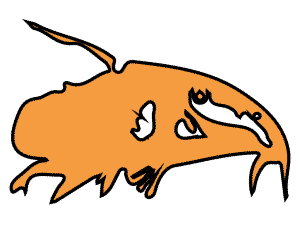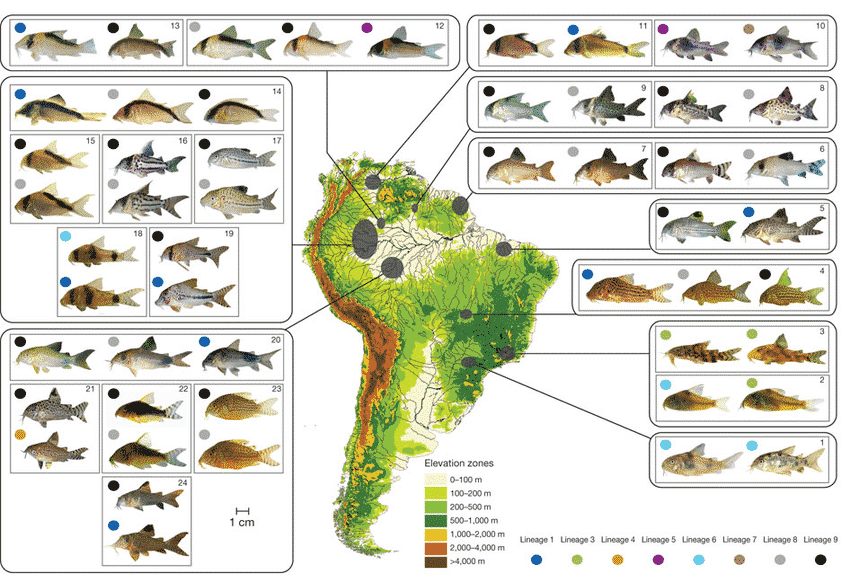Corydoradinae Lineages
A lot of change is coming to the naming and organisation of the Cory cats
Overview of Cory Lineages
The Corydoradinae sub-family today (2023) consists of the following family names:
- Aspidoras
- Brochis
- Corydoras
- Scleromystax
The other sub-family is Callichtyinae, and they both belong to the family Callicthyidae.
When I write Lineage, I'm talking about Genetic Lineage, or as it's also known, Genetic Pedigree.
In a paper "Evolution, Ecology and Taxonomy of the Corydoradinae Revisited", from 2011 by Markos A Alexandrou & Martin I Taylor a new systematic revision based on 9 Lineages was proposed. This website is using this article as a base for grouping the different species. They suggest new names or resurrected names for some of the lineages, but we have to wait for further research before they can be actually used.
It is however not as clearcut as that. One of the lineages, Lineage 8, has four subgroups, Sub-clade 1 (Brochis) through 4, which complicates things. Sub-clades 2 through 4 will need new family names. Also 2 species in Lineage 2 seems to be something other than Aspidoras and might also need a new family name. This means we might end up with the four families above split into 12 families!
Regardless it's clear that there will be huge changes coming to our Corydoradinae taxonomy over the coming years.
Chart of relation between Lineages
Original can be found here: ResearchGate
Mimetic species are different species looking alike, I will write an article later about this.
The pie chart shows percentage of mimetic species per lineage. Branches with mimetic species at tips are indicated with coloured circles (coded by lineage). Nodes with support below 0.8 (Bayesian inference; BI) probability and 70% (maximum likelihood; ML) are denoted with black open circles. Codes on pictures indicate snout types as determined by morphometrics and genetic lineage (L, long; S, short; IS, intermediate short; XL, extra long; IL, intermediate long). Representative images of morphotypes and colour patterns clockwise from lineage 1: (L-1) Corydoras maculifer, (L-1) Corydoras simulatus, (L-1) Corydoras sp. C109, (L-1) Corydoras sp. C092, (L-1) Corydoras narcissus; (S-2) Aspidoras poecilius*; (L-3) Scleromystax prionotus; (IS-4) Corydoras mamore; (IS-5) Corydoras sp. CW019, (IS-5) Corydoras nijsseni; (S-6) Corydoras paleatus, (S-6) Corydoras nattereri; (S-7) Corydoras sp. CW026; (XL-8) Corydoras multiradiatus*; (IS-8) Corydoras sodalis*; (IL-8) C. imitator, (IL-8) Corydoras bethanae (CW006), (IL-8) Corydoras seussi, (IL-8) Corydoras sp. C122; (S-9) Corydoras sp. C091, (S-9) Corydoras gossei, (S-9) Corydoras adolfoi, (S-9) Corydoras metae, (S-9) Corydoras araguaiaensis, (S-9) Corydoras arcuatus, (S-9) Corydoras julii.
*Non-mimetic taxa.
Map of Geographical distribution of mimetic communities
Original can be found here ResearchGate.
Genetic lineages are denoted by coloured circles; small grey rectangles represent independent mimetic communities numbered 1–24. Larger black rectangles indicate communities belonging to the same drainage or basin. Grey ellipses indicate approximate geographical distribution. Species images: (1) Corydoras paleatus, Corydoras ehrhardti; (2) Corydoras nattereri, Scleromystax prionotus; (3) Scleromystax barbatus, Scleromystax macropterus; (4) Corydoras maculifer, Corydoras sp. C122, Corydoras araguaiaensis; (5) Corydoras julii, Corydoras sp. C109; (6) Corydoras oiapoquensis, Corydoras condisciplus; (7) Corydoras sp. C135, Corydoras sp. C136; (8) Corydoras evelynae, Corydoras sp. CW013; (9) Corydoras kanei, Corydoras crimmeni; (10) Corydoras sp. CW019, Corydoras sp. CW026; (11) Corydoras metae, Corydoras simulatus; (12) Corydoras imitator, Corydoras adolfoi, Corydoras nijsseni; (13) Corydoras serratus, Corydoras cf. arcuatus; (14) Corydoras narcissus, Corydoras bethanae (CW006), Corydoras arcuatus; (15) Corydoras sp. C084, Corydoras sp. C156; (16) Corydoras sp. CW028, Corydoras pulcher; (17) Corydoras trilineatus, Corydoras leopardus; (18) Corydoras tukano, Corydoras sp. CW011; (19) Corydoras sp. C091, Corydoras sp. C092; (20) Corydoras similis, Corydoras sp. C066, Corydoras ourastigma; (21) Corydoras cruziensis, Corydoras mamore; (22) Corydoras gossei, Corydoras seussi; (23) Corydoras sterbai, Corydoras haraldshultzi; (24) Corydoras sp. C076, Corydoras sp. C077.
The C- and CW-Number systems
The system with C-numbers was introduced in 1993 in the German Aquarium Magazine DATZ and covers the subfamily Corydoradinae of the Callichtyidae catfish.
When they started this numbering it was mainly used for new species that were collected but there were still a lot of species that were already established in the hobby that never got a C-number.
The CW-numbers from Ian Fuller's site CorydorasWorld.com is filling that gap and adding species that are not covered by the DATZ Magazine.
Here is a great article over on Scotcat.com that explains it in more detail: What the heck is a CW number?
Lineage 1 - Saddle-nosed Corydoras
Example species below: Corydoras blochi.
This base group of "saddle-nosed" species should remain as Corydoras, as first described by Lacépède in 1803. The type species for the genus will remain Corydoras geoffroy. Long snouted species such as Corydoras fowleri are at the base of the Corydoradinae group.
To see all the species that are included in Corydoradinae Lineage 1 go here:
Corydoras Lineage 1 - Saddle-nosed Corys
Lineage 2 - Aspidoras
Example species below: Aspidoras cf. spilotus.
This group should remain as Aspidoras (Ihering, 1907) with the type species: A. rochai. All known Aspidoras belong to this lineage apart from A. pauciradiatus. Both Corydoras gladysae (Lineage 6) and Corydoras petracinii (Lineage 6) seem more closely related to Aspidoras, but they lack certain traits defining Aspidoras. They might therefore require a new generic name (Calvino and Alonso, 2009). Further studies need to be made to better understand the relationships of these species to Aspidoras.
To see all the species that are included in Corydoradinae Lineage 2 go here:
Corydoras Lineage 2 - Aspidoras
Lineage 3 - Scleromystax
Example species below: Scleromystax sp. CW038.
All known Scleromystax belong to lineage 3 and this group should remain as Scleromystax (Günther, 1864) with the designated type species: Scleromystax barbatus.
To see all the species that are included in Corydoradinae Lineage 3 go here:
Corydoras Lineage 3 - Scleromystax
Lineage 4 - "Dwarf Species"
Example species below: Corydoras guapore.
Lineage 4 includes two of the dwarf species, so they suggest to resurrect the disused Microcorydoras (Myers, 1953), with the designated type species: Corydoras hastatus. Oddly enough not all species in this group are real dwarfs, but they are closely related and have similar color patterns throughout the larval development.
Also note that a small species like Corydoras habrosus is not included here.
To see all the species that are included in Corydoradinae Lineage 4 go here:
Corydoras Lineage 4 - "Dwarf Species"
Lineage 5 - "elegans" group
Example species below: Corydoras sp. CW044.
This group contains species known as the ‘elegans’ group. During a revision the genus name Gastrodermus could be resurrected, with the designated type species Corydoras elegans. C. gracilis is the basal species in this group and Aspidoras pauciradiatus belongs to this lineage rather than Aspidoras (Lineage 2).
To see all the species that are included in Corydoradinae Lineage 5 go here:
Corydoras Lineage 5 - "elegans" group
Lineage 6 - "true" Corydoras
Example species below: Corydoras albolineatus.
Species within Lineage 6 have always been classified under the genus Corydoras. There are no synonymous disused generic names available so it would be necessary to describe a new genus with a new type species.
To see all the species that are included in Corydoradinae Lineage 6 go here:
Corydoras Lineage 6 - "true" Corydoras
Lineage 7 - "aeneus" group
Example species below: Corydoras eques.
This group contains all species within the ‘aeneus’ group. During a revision the genus name Osteogaster (Cope, 1871) would be resurrected , with the type species: Corydoras eques.
The most basal species in this group are Corydoras melanotaenia and Corydoras aeneus from Trinidad. Corydoras zygatus and Corydoras rabauti are both within this group and seems to be more closely related to each other than they are to any other species in this group.
Most closely related to these species are Corydoras aeneus spp. from the Parana drainage (originally known as Corydoras macrosteus).
The Amazonian species form a group within this lineage, with Corydoras aeneus from Suriname and Guyana separated from species from Peru where the ‘laser’ species are found.
To see all the species that are included in Corydoradinae Lineage 7 go here:
Corydoras Lineage 7 - "aeneus" group
Lineage 8 - Brochis et al.
Example species below: Corydoras cf. crypticus (sub-clade 4).
Lineage 8 contains mainly the long snouted but deep bodied species, but also includes Brochis, that was recently synonymized with Corydoras (Britto, 2003). The name Brochis would most likely be resurrection during a revision, with the designated type species Brochis splendens. There are also 3 more sub-clades that would need new names.
To see all the species that are included in Corydoradinae Lineage 8 go here:
Corydoras Lineage 8 - Brochis et. al.
Lineage 9 - "classic short-snouts"
Example species below: Corydoras gossei.
The species in this lineage are the classic ‘short snouted’ species such as Corydoras adolfoi. When revised it would likely mean the resurrection of the name Hoplosoma (Agassiz, 1846). The designated type species would be Corydoras punctatus. This lineage is very species rich and many of them have evolved relatively recently.
To see all the species that are included in Corydoradinae Lineage 9 go here:
Corydoras Lineage 9 - "classic short-snouts"


